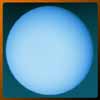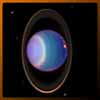You are seeing this message because you are using an out-of-date browser.
Please click here for more information.
A Seemingly Featureless Planet
Uranus, along with Neptune and Pluto, is in the most distant region of our solar system. The giant planet, which is another of the gas giants of our solar system, is more than twice as far away from the Sun as Saturn. If you get a chance to look at Uranus through a telescope, all you will see is a faint blue disk that appears exceptionally dull and lifeless. Even pictures sent back by the Voyager mission and the Hubble Space Telescope seem to show that Uranus is a dull, unexciting place.
As always, though, things aren't what they seem. Uranus has many interesting features, including its ring system, varied moons and much more. The bland face that the planet shows to us humans hides high speed winds, the fact that Uranus is tilted on its side and a very mysterious weather system. Read on to find out more about this mysterious world!
A Pale Blue-Green Disc
Although the Voyager spacecraft visited the seventh planet during its epic journey through our solar system, the pictures it sent back from Uranus were somewhat disappointing. We had hoped to see some color bands like there are on Jupiter or at least some faint colors, but the face the planet presents doesn't seem to vary, regardless of how close or far away from it you are.
Uranus, unlike Jupiter or Saturn, does not seem to have a solid core of any kind. The planet does contain some rocky material, but the planet is almost all gas, with the outer layer of methane providing the blue color we see in the picture at the right.
The pale blue image we see of Uranus hides the fact that the surface of the planet is swept by "winds" moving along at several hundred miles per hour. Scientists were able to detemine this by carefully studying the images that Voyager sent back.
A World on Tilt
When Voyager arrived at Uranus, it discovered a number of moons that were unknown to us. In addition, we found out that the planet is tilted on its side! All the other planets in our solar system pretty much have their equator lined up directly with the Sun. Uranus's equator is tilted at almost right angles to the Sun, which gives the planet very unusual seasons and gives us a different view of the planet depending on when we look at it. This proves once again that things are hardly ever as they seem on the surface.
Click on the link at right to find out more about the planet's tilt and what effects it has.
A Wide Variety of Very Unusual Moons
Before the Voyager mission arrived at Uranus, we knew that Uranus had five moons, but we didn't really know much about them because of the planet's great distance from the Sun. What a surprise we had waiting for us!
Not only did Voyager show us that there were eleven more moons orbiting the giant planet, it also revealed that the moons were very interesting in their own right.
There was a moon with cliffs on it higher than Mount Everest here on Earth, one with one very smooth side and one very rough side and much, much more.
Click on the link at right to find out more about the some of the fascinating moons of Uranus.
Solve the Puzzle!
Find Out More About Uranus
- Uranus Page at the Nine Planets Site
- The Uranus section of the Nine Planets site has more detail about this mysterious world.
- The Voyager Mission
- The Voyager mission sent back almost all of the pictures of Uranus that we have used in this section.
Get the Acrobat file for this topic
There is an Adobe® Acrobat® file (67k) for Uranus. You can view the file online by clicking
here. You can save the file on your computer by right-clicking on the link.
You will need the free
Adobe® Acrobat® ReaderTM
to view the file.
This entire site copyright © 2003 Astronomy for Kids - all rights reserved




